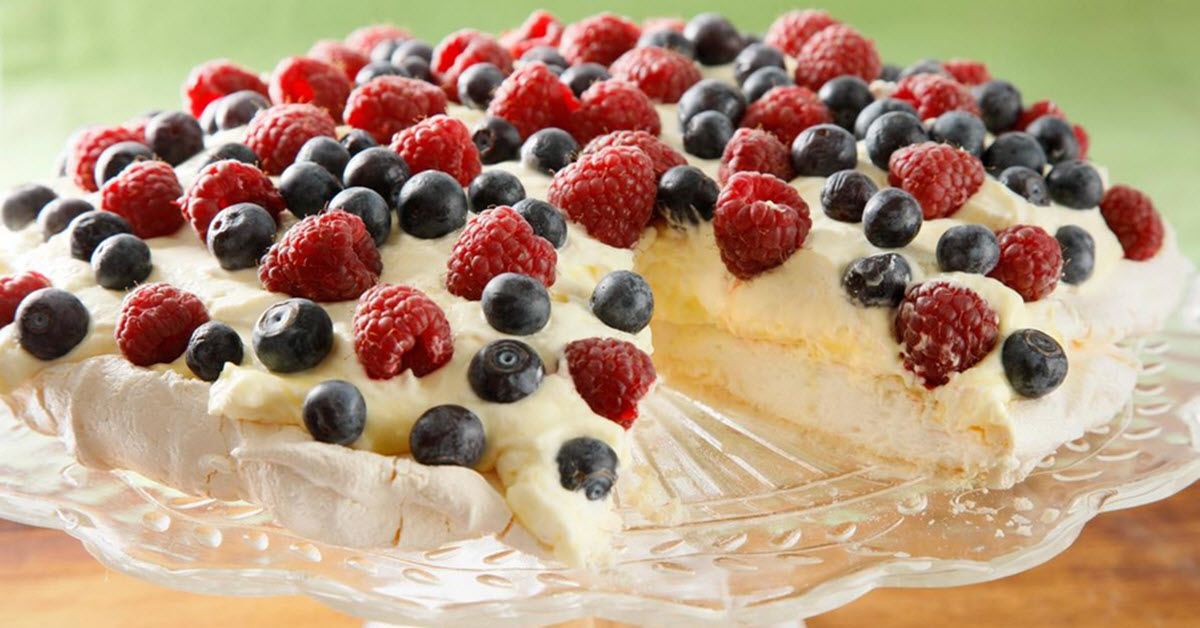Pavlova
Pavlova is a meringue-based dessert named after the Russian ballerina Anna Pavlova. The meringue in a pavlova is soft and marshmallow-like inside while being crisp and crusty on the outside, and it is topped with cream and various fruits and berries.
Even though Anna Pavlova was Russian, the desert is not. It is strongly associated with Australia and New Zealand and is believed to have been created in honor of the ballerina either during or after one of her tours to this part of the world in the 1920s.

Pavlova in Australia
In Australia, pavlova is especially popular during summer time celebrations – including Christmas. The meringue part of the pavlova can be made well in advance and stored in an airtight container until it is time to decorate it with whipped cream, fruits and berries. This means it wont require any hot oven on Christmas Day itself.
Pavlova recipe
There are many different ways of making Pavlova. In this recipe, the meringue is adorned with cream and mango, kiwifruit, passion fruit, blueberries and strawberries.
Ingredients
- Butter for greasing
- Some cornflour to dust the butter with
- 6 egg whites
- 1 ¼ cup of caster sugar
- 2 teaspoons cornflour
- 1 teaspoon white vinegar
- ½ teaspoon vanilla extract
- 1 1/3 cup thickened cream (If you like sweet cream, stir in 2 tablespoons of icing sugar.)
- 2 kiwifruits, peeled, thinly sliced
- Pulp of 2 passion fruits
- ¾ cup strawberries, halved
- ½ cup mango, peeled, cubed
- ¼ cup blueberries
Instructions
- Preheat the oven to 120 degrees C.
- Line an oven tray with foil. Grease the foil with butter. Dust the butter with cornflour. Shake off any excess cornflour. Mark a circle on the foil, with a diameter of approximately 25 cm.
- In a bowl, whisk egg whites until soft peaks have formed. It can be done by hand, but using an electric whisk will be much easier and quicker.
- Gradually whisk in the caster sugar, one tablespoon at the time. Make sure all sugar have entered completely before you add any more. Your goal is a glossy meringue batter where all the sugar is dissolved. You can test the batter by rubbing it between your fingers. Can you feel any sugar granules? If so, it hasn’t dissolved properly yet.
- Add cornflour, vinegar and vanilla to the batter and whisk to combine it. Don’t overdo it; you should stop whisking as soon as the new ingredients are well blended into the batter.
- Spoon batter inside the marked circle on the oven tray. Smooth the top and the sides. Use a small spatula to build little peaks around the edge.
- Put the meringue in the oven and bake until it is dry to the touch. This should take about 90 minutes since the temperature is so low.
- Turn off the oven, but do not attempt to move the meringue. Just leave the oven door ajar and let the meringue cool down inside the oven, without being disturbed.
- When the meringue has cooled down to room temperature, carefully take it out of the oven and transfer it to a serving plate.
- Spoon thickened cream on top of the meringue.
- Decorate the cream using the fruits and berries.
- Serve!
